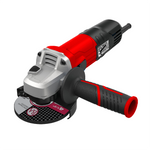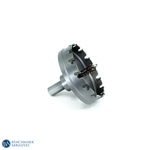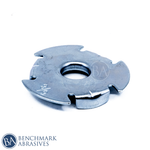
Reviving Your Flap Discs: Effective Techniques to Deglaze and Extend Lifespan

Summary:
Glazed flap discs can slow you down, but not every deglazing method is worthwhile. Skip the freezer tricks and open flames - reverse grinding and carb cleaner are the real champions here. Reverse rotation removes the glaze without too much wear, while carb cleaner helps loosen those fibers for better performance. Other techniques like concrete grinding and oven heating don't offer much benefit and can reduce the lifespan of your disc.
Pro Tips:
- Keep an eye on the glazing (if there's no spark, you have a problem).
- Use reverse grinding from time to time.
- Avoid those drastic DIY hacks - they'll wear out your disc quickly.
- Don't forget your safety gear - your eyes will appreciate it.
Revive your flap discs and save money.
Have you ever had one of those days where your flap disc stops cutting midway through a crucial job, leaving you standing there looking like a lost puppy? Yeah, we've all been there. Flap discs are the unsung heroes of metalworking—grinding away tirelessly until they suddenly don't. Glazing is like the hangover of metalworking tools—annoying, persistent, and seemingly impossible to fix. But fear not, friends, today we're here to bust some myths and share proven techniques to revive those stubborn discs, saving you a pretty penny. So, grab a coffee, pull up a chair, and get down to business.
Understanding Flap Disc Glazing
First things first: What the heck is glazing, anyway? Glazing is when your flap disc's abrasive material becomes shiny and smooth, making it about as useful as a screen door on a submarine. It's usually caused by too much heat and pressure during use. You'll know your disc is glazed when the sparks disappear and your disc starts sliding like ice skates rather than grinding metal.
Debunking Common Myths about Deglazing
If you've ever Googled “How to deglaze a flap disc,” you've probably encountered some wild theories. From freezing your discs to grilling them like burgers, the internet is full of "helpful" advice. Today, we will sort fact from fiction and see what works.
Tested Methods to Deglaze Flap Discs – The Real Deal
-
The Freezer Method: Let's start by putting our discs on ice. The theory is that freezing the disc makes the glaze brittle enough to flake off. Unfortunately, the freezer won't be good unless your discs are beer cans. The disc stayed about as glazed as a donut.
-
Open Flame Technique: Next up, playing with fire! Sure, roasting marshmallows sounds fun, but are you trying this on your flap discs? Not so much. While this method burns off some glaze, it has a dangerous side. Unless you like playing firefighter, maybe skip this one.
-
Concrete Grinding: Ah, concrete—the magical cure-all, according to every backyard expert. Did grinding on concrete work? Well, kinda. It knocked off some glaze but left the disc rougher than your buddy after a wild weekend. Verdict: better than nothing, but not your go-to.
-
Diamond Wheel Technique: Diamonds might be a girl’s best friend, but they don't sparkle for glazed discs. Using a diamond wheel left us disappointed. The glaze laughed in our faces, and we’re still salty about it.
-
Wire Wheel Methods: We tested two approaches here. First, run a wire wheel across the disc. The glaze thinned, but the fabric backing started showing through, looking uglier than a truck after mudding. Reverse the technique, and the result didn't change much. This method is hit-or-miss.
-
Hard Disc Grinding: Next, we tried grinding on a hard disc. This slightly improved but still left plenty of fabric intact, which was about as helpful as a screen door on your bass boat.
-
Water Soaking: Could a simple dunk in water do the trick? The idea is to soften the fibers and glue, making the glaze easier to remove. Unfortunately, results were minimal, but it’s a harmless method worth trying if you're desperate.
-
Oven Heating Method: We baked the discs in the oven (without the pizza, sadly). Heating the discs slightly improved performance, but your spouse probably won’t appreciate finding a stack of abrasive discs in the oven.
-
Dressing Tools: Dressing tools are fantastic for grinding wheels, but for flap discs? They were about as effective as yelling at your tools to fix themselves. The shiny spots disappeared, but the fabric hung on stubbornly.
-
Carburetor Cleaner Application: Here's a surprise—the carb cleaner came through like a champ! Spraying the disc and letting it soak briefly effectively loosened the glaze, significantly improving cutting performance. Just watch out for fumes unless you're looking for a free headache.
-
Reverse Grinding: Finally, the grand champion—reverse grinding. Spinning your disc backward might seem weird, but it genuinely works wonders. This method peeled off glaze like peeling off old paint, drastically improving performance. Who knew going backward was the new forward?
Which Methods Actually Work?
After testing all these crazy theories, here's what matters:
- Top performers: Reverse grinding and carburetor cleaner.
- Decent but questionable: Concrete grinding, oven heating.
- Least effective: Diamond wheel, freezer method, open flame, dressing tools.
|
Method |
Effectiveness and Recommendation |
|
Reverse Rotation |
Highly Effective (Recommended method) |
|
Grinding on Comer |
Moderately Effective (Damaging method) |
|
Carb Cleaner |
Moderately Effective |
|
Open Flame |
Slightly Effective |
|
Water |
Marginal/Unreliable |
|
Oven |
Marginal/Ineffective |
|
Freezer |
Ineffective (initial fluke misleading) |
|
Concrete |
Made Performance Worse |
|
Hard Disc |
Made Performance Worse |
|
Diamond Wheel |
Made Performance Worse |
|
Dressing Tool |
Made Performance Worse |
| Wire Wheel | Made Performance Worse |
1. Physical Abrasion Methods (Concrete, Hard Disc, Diamond Wheel, Dressing Tool, Wire Wheel)
-
Result:
-
Generally worsened disc performance due to excessive damage to the fabric and abrasive surface.
-
Produced discs that cut less effectively than the control (already glazed) disc.
2. Chemical/Thermal Methods (Freezer, Oven, Open Flame, Water, Carb Cleaner)
-
Results Varied:
-
Freezer: Initial promising result, but retesting indicated inconsistent/fluke performance. Final verdict: Ineffective.
-
Oven: Slight discoloration but minimal impact. It's not subIt'stially helpful.
-
Open Flame: Provided a slight performance boost, somewhat consistent.
-
Water: Marginal improvement, possibly negligible or fluke.
-
Carburetor Cleaner: Moderate performance improvement—chemicals slightly loosened fibers.
3. Reverse Rotation Method (Running Disc Backwards)
-
Consistently Effective: Showed clear and repeatable improvement in disc performance.
-
Mechanism: Reverse rotation likely grabs and removes excess fabric and dull abrasive layers effectively without major damage to intact abrasive underneath.
4. Traditional Method (Grinding on Corner/Edge)
-
Moderate Improvement: Improved performance slightly better than flame, but noticeably inferior to reverse rotation.
-
However, this method was found to be destructive, significantly reducing disc life compared to reverse rotation.
So, forget internet myths—stick with reverse grinding and carb cleaner for hassle-free results.
Expert Recommendations for Deglazing and Maintaining Flap Discs
To make your discs last longer, follow these pro tips:
-
Regularly inspect your discs; if sparks stop flying, stop and check.
-
Reverse grinding periodically to keep the glaze at bay.
-
Avoid harsh methods like open flame and aggressive grinding—unless you prefer buying discs every payday.
-
Always wear proper safety gear because losing an eye isn’t the goal here, folks.
Conclusion
Flap disc glazing might seem unbeatable, but with the right techniques, you can return to grinding like a pro. With these simple tips, you can save money, reduce waste, and improve performance. And remember friends, don't let friends grind with glazed discs.



































































